
Craspedia is a genus of flowering plants in the family Asteraceae commonly known as billy buttons, billy balls, and woollyheads. They are native to Australia and New Zealand where they grow in a variety of habitats from sea level to the Alps. The genus is found in every state of Australia but not in the Northern Territory. In New Zealand, Craspedia is found from East Cape on the North Island south to Stewart Island. It also occurs on Campbell Island and the Chatham Islands.

Banksia canei, commonly known as the mountain banksia, is a species of shrub that is endemic to southeastern Australia. It is generally encountered as a many-branched shrub that grows up to 3 m (10 ft) high, with narrow leaves and the yellow inflorescences appearing from late summer to early winter. The old flowers fall off the spikes and up to 150 finely furred follicles develop, which remain closed until burnt in a bushfire. Each follicle bears two winged seeds. Response to fire is poorly known, although it is thought to regenerate by seed. Birds such as the yellow-tufted honeyeater and various insects forage among the flower spikes. It is frost tolerant in cultivation, but copes less well with aridity or humidity and is often short-lived in gardens. One cultivar, Banksia 'Celia Rosser', was registered in 1978, but has subsequently vanished.

Ozothamnus is a genus of plants found in Australia, New Zealand and New Caledonia.

Ozothamnus diosmifolius is an erect, woody shrub in the family Asteraceae and is endemic to eastern Australia. Common names for this species include rice flower, white dogwood, pill flower and sago bush. It has dense heads of small white "flowers" and is often used in floral arrangements.

Athrotaxis x laxifolia is a tree belonging to the genus Athrotaxis endemic to Tasmania. It is a hybrid between Athrotaxis cupressoides and Athrotaxis selaginoides.
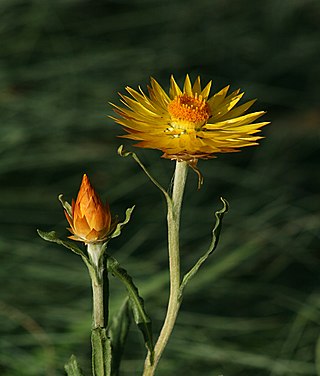
Xerochrysum subundulatum is a flowering plant in the family Asteraceae, native to Australia, growing in Victoria, New South Wales and Tasmania.

Chrysocephalum semipapposum, commonly known as clustered everlasting is a perennial shrub native to Australia. Clustered everlasting belongs to the family Asteraceae. C. semipapposum produces terminal flowers heads in clusters, mainly between spring and early summer with silver-grey appearing stems and branches. It grows up to 40 cm high and 60 cm high, although there have been some varieties which can grow up to 1 m. C. semipapposum is often confused with Chrysocephalum apiculatum or 'yellow buttons', due to their similar appearances. C. semipapposum has 4 different subspecies, however they lack distinctive qualities and are often hard to identify. C. semipapposum is endemic to Australia and can be found in multiple states, most notably within Victoria. The plant is found in a variety of habitats including dry rocky regions. Clustered everlasting often grows sparsely and is rarely found in abundance and can be mistaken for a weed. Clustered everlasting has many uses, including as a source of nectar for butterflies, cut flowers or as an addition to a garden.

Ozothamnus ferrugineus, commonly known as tree everlasting, is a member of the genus Ozothamnus, of the Asteraceae family – one of the largest families of flowering plants in Australia. Native to the Australian states of New South Wales, Victoria, South Australia, and Tasmania, it forms an erect shrub or small tree between 2 and 3 metres in height.

Ozothamnus obcordatus, the grey everlasting, is a shrub in the family Asteraceae, native to the states of Queensland, New South Wales, Victoria and Tasmania in Australia.

Olearia floribunda, commonly known as heath daisy-bush, is a species of flowering plant in the family Asteraceae and is endemic to south-eastern Australia. It is an upright, spreading shrub with egg-shaped leaves and white and yellow or mauve, daisy-like inflorescences.

Ozothamnus alpinus, commonly known as alpine everlasting, is a flowering plant in the family Asteraceae. It is endemic to alpine and subalpine areas in south-eastern continental Australia.

Ozothamnus rogersianus, commonly known as Nunniong everlasting, is a shrub in the family Asteraceae. It is endemic to Victoria, Australia.

Ozothamnus thyrsoideus, commonly known as sticky everlasting, is a flowering shrub, endemic to south-eastern Australia. It grows to between 0.5 and 2 metres in height. Leaves are 15 to 30 mm long and 1.5 to 2 mm wide. Flowerheads appear in terminal corymbs in the summer.
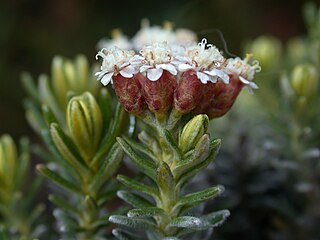
Ozothamnus ledifolius is a shrub, from the family Asteraceae and one of 54 species from the genus Ozothamnus. Harold Frederick Comber (1897–1969), an English horticulturist and plant collector, introduced Ozothamnus ledifolius in 1929 on mountains of Tasmania above 2500 ft. high from the seeds collected from 4000 ft. height.
Cassinia ozothamnoides, commonly known as cottony haeckeria, is a species of flowering plant in the family Asteraceae and is endemic to Victoria, Australia. It is an erect shrub with hairy branchlets, linear leaves and corymbs of up to two hundred flower heads.
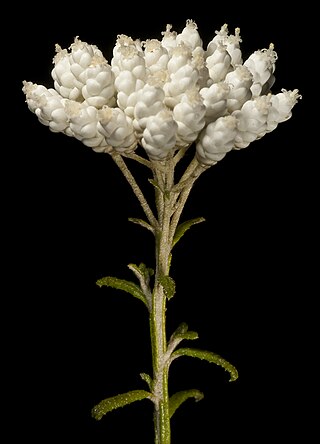
Ozothamnus occidentalis is a shrub in the family Asteraceae, native to Western Australia.
Ozothamnus tesselatus, commonly known as tesselate everlasting, is a flowering plant in the family Asteraceae. It is a small shrub with woolly branches and globular heads of whitish to straw-coloured flowers.
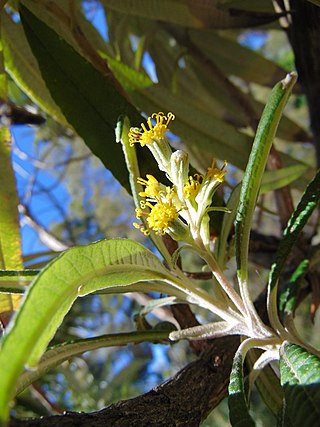
Bedfordia salicina, commonly known as Tasmanian blanketleaf, is an endemic angiosperm of Tasmania, Australia. It is widespread throughout wet sclerophyll forests, moist gullies and intermediate forests and woodlands between wet and dry sclerophyll communities. Bedfordia salicina is abundant at low elevations, on dolerite, sandstone and mudstone substrate, east of Tylers line. Alternating leaves droop down to blanket the stem, coining the species common name, blanketleaf.
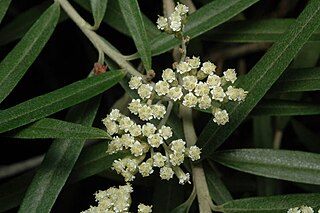
Ozothamnus stirlingii, commonly known as Ovens everlasting, is a flowering plant in the family Asteraceae and grows in New South Wales, Victoria and the Australian Capital Territory. It has globose-shaped white flower heads and sticky leaves.

Ozothamnus lycopodioides, commonly known as clubmoss everlastingbush, is a plant species endemic to Tasmania. The specific epithet "lycopodioides" refers to the resemblance of the foliage to that of plants (clubmosses) in the Lycopodium genus.


















